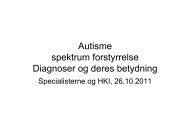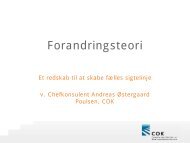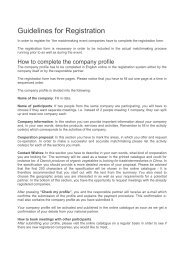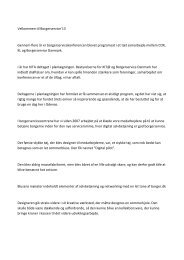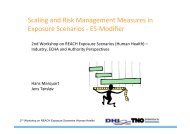11-13 May 2012 Helsingør - Denmark www.networkbio.org
11-13 May 2012 Helsingør - Denmark www.networkbio.org
11-13 May 2012 Helsingør - Denmark www.networkbio.org
Create successful ePaper yourself
Turn your PDF publications into a flip-book with our unique Google optimized e-Paper software.
STEPhAN M. fELLER, WIMM,<br />
OxfORD UNIVERSITY, OxfORD, UK<br />
abStract For SPeakerS<br />
How are complex signal computations in cells accomplished by multi-protein complexes assembled on<br />
‘intrinsically disordered’ platform proteins? The N terminal folding nucleation (NFN) hypothesis<br />
Proteins with little recognisable secondary structure -according to current prediction programs -comprise<br />
one third of the human proteome. Some of these are large and serve as docking platforms for many proteins<br />
involved in the processing of cell signals, thereby creating large signalosomes in which signal computations<br />
are performed. It was always difficult to conceptualise how an intrinsically disordered, i.e. ‘chaotic’ signal<br />
computation platform protein should be able to mediate effective pathway crosstalk in cells. However, we<br />
have now first evidence that the cancer-relevant Gab family proteins display a previously unrecognised<br />
<strong>org</strong>anisation (Simister et al. 20<strong>11</strong>, PLoS Biol; Simister & Feller <strong>2012</strong>, Mol BioSystems). Gab proteins contain<br />
N terminal PH domains followed by long ‘tail regions’ supposedly lacking any structure. Our data point to<br />
several specific interactions of the Gab1 tail with is structured N-terminus. These generate, around the PH<br />
domain, tail loop structures, in which docking sites for pathway-specific signaling proteins are clustered.<br />
Functionally dedicated, distinct sub-complexes can assembly in these loops. If this model is correct, it is<br />
easy to see how effective signaling pathway crosstalk occurs: simply by interactions of distinct sub-complexes<br />
bound to specialised loops, which are held in place by their interactions with the PH domain. We believe<br />
that proving this hypothesis, which is also relevant to multiple similarly structured signaling protein families<br />
(p<strong>13</strong>0Cas, IRS/Dok, Frs etc.), will have a profound impact on the understanding of molecular signal computing<br />
in cells and we will report on our first results.<br />
abStract For SPeakerS<br />
ThEO KNIJNENBURG<br />
NEThERLANDS CANCER INSTITUTE, DIVISION Of MOLECULAR CARCINOGENESIS<br />
PLESMANLAAN 121, 1066Cx AMSTERDAM, ThE NEThERLANDS<br />
MAThEW J. GARNETT<br />
CANCER GENOME PROJECT , WELLCOME TRUST SANGER INSTITUTE<br />
hINxTON CAMBRIDGE CB10 1SA, UNITED KINGDOM<br />
GUNNAR W. KLAU<br />
LIfE SCIENCES GROUP, CENTRUM WISKUNDE & INfORMATICA<br />
SCIENCE PARK 123, 1098 xG AMSTERDAM, ThE NEThERLANDS<br />
fRANCESCO IORIO<br />
EUROPEAN BIOINfORMATICS INSTITUTE, WELLCOME TRUST GENOME CAMPUS<br />
hINxTON CAMBRIDGE CB10 1SD, UNITED KINGDOM<br />
JULIO SAEz-RODRIGUEz<br />
EUROPEAN BIOINfORMATICS INSTITUTE, WELLCOME TRUST GENOME CAMPUS<br />
hINxTON CAMBRIDGE CB10 1SD, UNITED KINGDOM<br />
ULTAN MCDERMOTT<br />
CANCER GENOME PROJECT , WELLCOME TRUST SANGER INSTITUTE<br />
hINxTON CAMBRIDGE CB10 1SA, UNITED KINGDOM<br />
LODEWYK WESSELS<br />
NEThERLANDS CANCER INSTITUTE, DIVISION Of MOLECULAR CARCINOGENESIS<br />
PLESMANLAAN 121, 1066Cx AMSTERDAM, ThE NEThERLANDS<br />
Drug sensitivity of cancer cell lines explained as a logic combination of mutations<br />
Cancer arises as a result of the acquisition of DNA mutations. It is still unclear which and how combinations<br />
of mutations are involved in tumor initiation and development. Two major challenges need to be addressed in<br />
order to systematically unravel these genetic interactions.<br />
First, large amounts of high quality data are necessary in order to ensure the statistical power required<br />
to uncover these genotype-to-phenotype relationships. Current advances in high-throughput biology are<br />
enabling the generation of very large datasets that should facilitate the detection of higher order genetic<br />
interactions. Here, we report on the analysis of a panel of 1000 cancer cell lines. The mutation status of 66<br />
known cancer genes has been characterized for each cell line in this panel. Additionally, these cell lines<br />
have been screened to model drug response with a large number (250+) of anti-cancer therapeutics. This<br />
dataset is part of the Cancer Genome Project at the Wellcome Trust Sanger Institute.<br />
The second challenge is to design a computational framework that employs a mathematical formalism rich<br />
enough to capture the underlying biological complexity, while limiting the computational complexity that<br />
would otherwise prohibit finding optimal (or even good) solutions in the vast combinatorial search space.<br />
We contribute to addressing this second challenge by proposing a novel computational approach based on<br />
integer programming that infers logic combinations of mutations that predict the observed drug response.<br />
The use of a logic formalism enables the formulation of intelligible models, from which the cancer biologists<br />
can generate a deeper understanding based on domain knowledge and easily formulate novel hypotheses<br />
and experiments.<br />
Our models show that for most drugs, combinations of mutations explain the drug response better than<br />
single mutations. For example, of the 8 BRAF inhibitors in the panel, the drug sensitivity to 3 of them is better<br />
explained using a logic combination of a BRAF mutation and one or more mutations in other genes, such<br />
as TET2. These results immediately suggest putative drug combination therapies.<br />
Additionally, cancer signaling pathways as annotated in e.g. the Pathway Interaction Database can be<br />
employed to dramatically reduce the search space and offer a mechanistic explanation of the uncovered<br />
gene combinations.<br />
14 / INB <strong>2012</strong> • <strong>11</strong>-<strong>13</strong> <strong>May</strong> <strong>2012</strong> <strong>www</strong>.<strong>networkbio</strong>.<strong>org</strong> / 15




